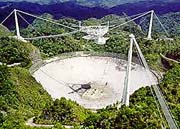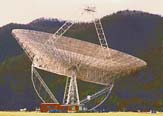Observatories
|
Arecibo Observatory |
The largest radio telescope in the world is at the Arecibo Observatory in Puerto Rico. Its giant dish measures 305 meters (1000 ft.) across and was originally built in 1963 to study Earth's ionosphere. For these studies a powerful radar is turned on and the response of the ionosphere is measured. A large dish is needed because only a small fraction of the radar energy is back-scattered and returns to the dish to be measured. Nowadays only a third of the telescope time is used for ionospheric studies, another third is dedicated to galaxies and the remaining third is allocated for pulsar astronomy.
|
(c) 1996 STSCI NRAO telescope before collapse |
|
(c) 1996 STSCI and after collapse |
|
(c) 1996 STSCI Max Plank Institute telescope in Effelsberg |
|
(c) 1996 STSCI Very Large Array |
Arecibo is clearly the telescope of choice when it comes to looking for new pulsars, since its enormous size makes the searches more sensitive and allows astronomers to discover hitherto undetected pulsars that would be too faint to see with smaller telescopes. The giant size of the telescope also has its disadvantages, however. For instance, the dish is too large to be steerable and must remain fixed on the ground. As a result it can only view that area of the sky which is directly above it, all along the path of the earth's rotation. This gives Arecibo access to a relatively small percentage of the entire sky. By comparison, most other telescopes can view between 75% and 90% of the sky.
The second, third, and fourth largest telescopes that are used (or will be used) for pulsar observations are, respectively, NRAO's telescope in West Virginia, the Max Plank Institute's telescope in Effelsberg, and NRAO's Green Bank Telescope also in West Virginia. All of these measure more than 100 meters (300 feet) in diameter and are fully steerable. The 100 meter NROA dish collapsed a few years ago and is being replaced by a better, 105 meter telescope.
These are the best telescopes to use for finding and studying pulsars that are outside the Arecibo range. Note that the Arecibo telescope's diameter of 305 meters is about 3 times that of the 100 meter dishes. But this means it has a collecting area 9 times as great, and achieves observations of comparable quality 81 times faster .
Still, there are many telescopes with diameters under 100 meters that are used very successfully for pulsar observations. Among these are Parkes in Australia and NRAO's 140 ft telescope.
It is also possible to simulate large telescopes by combining the signals from groups of smaller telescopes. These telescopes, or rather arrays of telescopes, can have collecting areas equivalent to a single dish of more than 100 meters across. One of the largest such arrays designed for aperture synthesis is the Very Large Array, a collection of 27 antennae each measuring 25 meters in diameter.
This content has been re-published with permission from SEED. Copyright © 2025 Schlumberger Excellence in Education Development (SEED), Inc.






